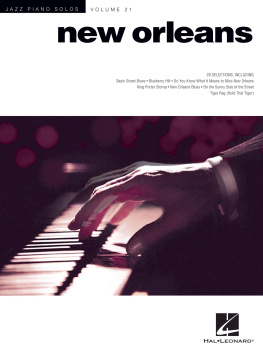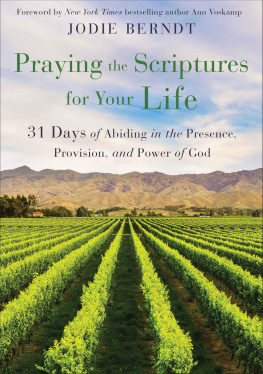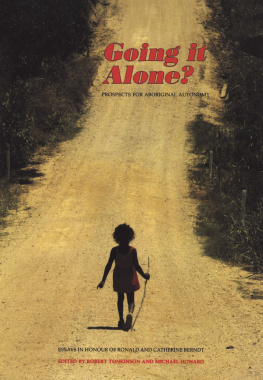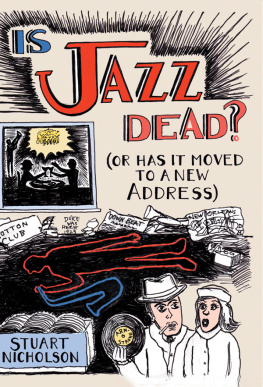Berndt Ostendorf
New Orleans
TRANSATLANTICA
Gnter Bischof, Editor
Volume 7: Berndt Ostendorf
New Orleans
Berndt Ostendorf
New Orleans
Creolization and all that Jazz
2013 by Studienverlag Ges.m.b.H., Erlerstrae 10, A-6020 Innsbruck
E-Mail:
Internet: www.studienverlag.at
All rights reserved. No part of this publication may be reproduced and electronically processed, duplicated or distributed without the written approval of Studienverlag Ges.m.b.H
Depending on the reading device used, varying depictions of the published texts are possible.
ISBN 978-3-7065-5721-4
Corporate design by Kurt Hretzeder
Layout: Studienverlag/Roland Kubanda
Cover: Studienverlag/Karin Berner
Photos: Image 1: Photo by Jutta Ostendorf
Image 2: Oliver Pork Chop Anderson at Harold Dudley Funeral 1985. Photo by Michael P. Smith. Copyright The Historic New Orleans Collection
This book is also available in a high quality printed version at your booksellers or directly from www.studienverlag.at.
Dedicated to the memory of Michael P. Smith (19372008)
Michael P. Smith, a New Orleans native and award-winning professional freelance photographer, spent a lifetime capturing the music, culture and folklife of New Orleans and Louisiana. He was well known for documenting New Orleans social club parades and jazz funerals, neighborhood Mardi Gras traditions, spiritual church ceremonies, and many of the city and states renowned jazz, blues, rhythm and blues, and gospel musicians. Smith photographed at every New Orleans Jazz & Heritage Festival from its inception in 1970 until his retirement in 2004. In a brilliant career that spanned more than four decades, he produced five books, and garnered a host of honors, including two fellowships from the National Endowment for the Arts. Smith was an inspiration, a role model and a mentor to many people in New Orleans and beyond. Michael was my Cicerone guiding me through the complex cultural layers of this intriguing city. The chapters in this book document what I learned from this inspiring ethnographer and friend.
Table of contents
by Gnter Bischof
Gnter Bischof
Preface
The essays in this volume are a tribute to and a showpiece of the ascendancy of the American Studies field in post-World War II Germany and Western Europe. Berndt Ostendorf has been a leading figure in that new field in postwar Europe. He does not shy away from making frequent references to his own intellectual autobiography in these essays. His chapter Growing up in the Fifties: Jazz, the Cold War and the Birth of American Studies represents a veritable showpiece of postwar intellectual formation of a young German escaping the burdens of German Nazi history by way of total immersion in American popular culture. He demonstrates how the new opportunities offered by student exchange programs what today we call international student mobility allowed young Germans (and young Austrians like myself) to embark on trajectories of Westernization and Americanization. Such escapes helped mastering difficult pasts and open new windows for post-Nazi intellectual formation. Clearly his visits of the United States as a high school pupil and later as a university student and lecturer offered personal and intellectual windows to a new life. Such a new world, both less stultifying and more inviting to foreigners, put Ostendorf on the path towards becoming a shaper of postwar German and Western European discourses about America.
Ostendorf held the chair of American Studies in Munich for more than 20 years (19812005) and produced a steady flow of essays and articles that defined many aspects of American cultural studies in the postwar European American Studies movement. He was a key translator and mediator of American academic discourses in Germany and Western Europe and in the process helped shape those debates on the continent. He was one of the first to venture into black studies in Europe, thus contributing to the formation of African-American cultural studies discourses in the 1980s. He was a key impresario in grounding the multi-Kulti-debate in Germany in the 1990s in the larger American context of that discourse. He contributed to a thorough understanding of American popular music and introduced it to the ethno-musicology discourses in Germany.
As chair of American Studies he regularly invited top-notch and cutting-edge American academics to come as Fulbright guest professor to his Amerika-Institut at the Ludwig-Maximilians-Universitt Mnchen. These guests immersed the Munich students in their innovative research interests and thus contributed to uplift them to participate in those innovative discourses. Both Sidney Mintz and the late George McGovern, the 1972 nominee for President of the Democratic Party (who also held a PhD in American History), taught in Munich as Eric Voegelin guest professors. When I served as a visiting guest lecturer in Munich in 1993/1994, David Blight (then Amherst College, now Yale University) was involved in doing his path-breaking research on Civil War memory later published in the prize-winning book Race and Reunion. Through these prominent visitors the Munich students came to inhale and reflect these discourses, at times even before they came to dominate the American intellectual landscape. Munich students often knew about these academic debates before they became popular in the US. So it went with many superstars of American academia who came to the Ostendorfs Amerika Institut in Munich.
Ostendorfs New Orleans essays collected in this volume give a cross-section of his amazingly diverse yet idiosyncratic contributions to the field of American cultural studies as seen through the lens and mirror of the rich cultural history of the Crescent City. Ostendorf penned these essays over a period of 30 years and during many visits to New Orleans, years before cultural studies became a buzzword in academia. In that sense he was an innovator, precursor and trend-setter in the field of cultural studies and an icon of New Orleans studies in Europe. Berndt Ostendorf taught for a semester at the University of New Orleans in the spring of 1989, exchanging with his friend Joseph Logsdon, who taught in Munich as a visiting DAAD professor that semester. He took advantage of his stay in New Orleans to practise deep immersion as a participant observer in a quasi-anthropological field study. This is when he encountered the photographer and ethnographer Michael Smith who became his friend and regularly took him along to Mardi Gras Indian parades. Smith introduced Ostendorf to second line parades and jazz funerals. Here he became interested in the Afro-Caribbean dance traditions in public spaces that fascinated him so much. The dance-driven musical culture of New Orleans and its many carnivalesque outrages during Mardi Gras and jazz funerals absorbed him as did the sensuous of the lively street scenes encountered every day in the libidinal economy of sin city USA.
As his autobiographical essay Growing up in the Fifties: Jazz, the Cold War and the Birth of American Studies shows he had already deeply imbibed the sounds and rhythms of American jazz and popular music as a statement of personal liberation from the German past. Now in New Orleans attending the music clubs and jazz festivals of New Orleans allowed him to experience the amazingly colorful musical scene of the Crescent City that never sleeps. Living in the city with his wife Jutta and being a gourmet and excellent chef himself allowed him to enter the world of New Orleans food culture and cuisine, yet another variation of experiencing the rich gumbo of ethnic influences on New Orleans popular culture and food ways. He followed the complex heritages of the three principal food traditions of New Orleans Creole, Cajun, and the down home fusion of NAwlins. Ostendorf came to appreciate New Orleans as the El Dorado of eating and public drinking and taught seminars about it in Munich. New Orleans caloric temptation he sees as the counterpoint to the bland food culture of the rest of America and its obsessions with dieting.










